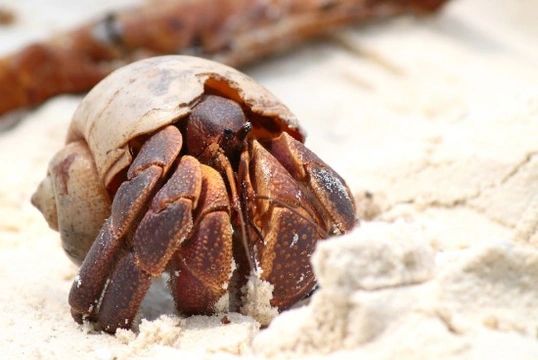
Hermit Crab Care: UK Pet Guide for Beginners
Land hermit crabs are one of the smaller species of land crab, which make the perfect pet for those without much space! Also sometimes known as the tree climbing hermit crab or the Caribbean hermit crab, they are found in the wild on the shores and riverbanks of the warmer climate of the Caribbean islands, and down as far as Mexico. Land hermit crabs are interesting and educational animals, and despite their name, are actually fairly social and active, and like to be kept in pairs or groups.
If you are looking for an interesting and attractive pet that is relatively low maintenance and fairly unusual, read on to learn more about what is required to keep land hermit crabs as pets.
Hermit crab shells
Hermit crabs are especially interesting and unusual, as they live in external shells rather than developing a particularly tough carapace on their own bodies. This means that you will need to provide a selection of shells within their enclosure to allow them to change their accommodation now and then, particularly as they grow and moult their external exoskeleton. A wide variety of different types of shells are suitable for hermit crabs, and a good selection should be made available in order to allow each crab to pick their perfect home! These are usually readily available to buy from aquatic retailers and specialist pet shops.
You can even introduce colourfully decorated shells into the tank to brighten up the appearance of your crabs, although the eventual choice of shell that any crab picks cannot be controlled by their owner!
Housing and accommodation
The size of the tank you will need to provide for your crabs depends largely on how many crabs you intend to keep; for a pair of land hermit crabs, a tank of around a foot square is fine, but for a small colony of crabs, the enclosure size should be a little larger.
You will need to line the bottom of the tank with a substrate of calcium-rich sand such as is sold specifically for crabs and reptiles. This sand retains water well, and can be sculpted and formed into burrows by your crabs without losing its integrity.
Hermit crabs also love to climb, so you should make sure that your tank is tall enough to allow this in safety without escape, and provide ornamentation such as upright logs and other furniture to keep your crabs entertained. Bogwood, cork, and resin ornaments such as those sold for fish tanks are all fine!
You do not actually need to provide an area of swimming water within the tank, although the sand should be kept damp at all times, and you will need to bathe your hermit crabs occasionally- more on this later on.
You will also need to provide a water dish and a food bowl within the tank.
What do they eat?
Hermit crabs do not have huge appetites, and only need a small amount of food each day. You can buy a specially prepared pot of hermit crab food pellets to make life easy, or feed your hermit crabs a balanced diet of a wide variety of foodstuffs. Hermit crabs are omnivorous, and will eat dried prawns, other fish and many fruits and vegetables. They even enjoy such widely varied foods as dog food and nuts, and special treats such as peanut butter on occasion! As crabs need a lot of calcium in order to support healthy growth, you should also feed a pinch of a calcium supplement such as Nutrobal mixed into something sweet now and again.
Fresh water should be available at all times.
Temperature and care
Land hermit crabs require a constant temperature of around 22 degrees Celsius, which can be achieved by placing a heat mat in the tank underneath the substrate. You should ensure that the heat mat has a thermostat to regulate the temperature, and keep a thermometer within the tank to monitor the ambient temperature and check for any anomalies.
Hermit crabs need to keep their bodies moist in order to prevent drying out inside of their shells, as this can prove fatal for the hermit crab. Ensure that the substrate of the tank is kept damp at all times, and dedicate a few minutes each week to bathing your hermit crabs, to recreate the normal moisture balance that hermit crabs achieve in the wild from living in damp conditions.
Bathing hermit crabs involves setting up a small bowl of water of around 20 degrees Celsius, and dunking them lightly into the water before draining them. Repeat the process, this time leaving the crab in the water until they begin to emerge from their shells, then remove them and replace them back in the tank, all clean and damp!
This procedure should be repeated on a weekly basis to ensure that your hermit crabs stay healthy and well.
Where to buy land hermit crabs
Land hermit crabs are sometimes available from pet shops that stock aquarium fish, or from specialist retailers that sell a rage of exotic pets. You can also buy hermit crabs from private breeders and sellers, who may be able to give you more advice and help with the care and housing of land hermit crabs than commercial enterprises can.
Check out land hermit crabs for sale by private advertisers here on Pets4Homes.



